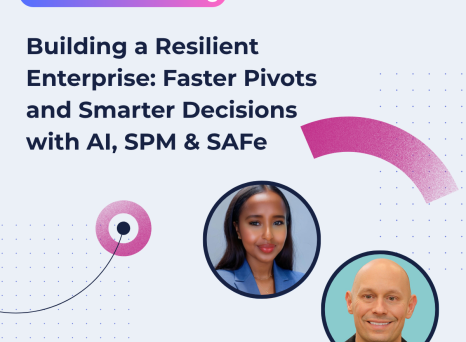The classic stage-gate process has transformed how businesses approach project and product management from a long-term perspective.
But, for some businesses, a more flexible, real-time variation of the stage-gate process can be revolutionary. Introducing: Agile stage-gate.
What is the Agile stage-gate project management model?
Agile stage-gate is a project management model. It combines stage-gate’s traditional structure—consisting of five stages and four gates—with the self-organized teams and short-cycle iterations promoted by Agile methodologies.
Typically, the “stages” associated with stage-gate—for example, the Development stage—are replaced by short, time-boxed increments called “sprints,” which last between one and four weeks.
At the end of every sprint, there is a working product (a deliverable) that key decision-makers and stakeholders can review, give feedback on, or approve at various gates. This enables the business to seek feedback from customers and users more frequently and quickly than with a traditional stage-gate process. Changes can be implemented quickly, speeding up time to market and tailoring the product to the project’s strategic needs.
However, just as no two organizations’ classic stage-gate processes will look the same, Agile stage-gate can take many forms depending on the requirements and products of the organization employing it.
What are the differences between Agile stage-gate and traditional stage-gate?
Agile stage-gate shares many similarities with the classic stage-gate process: projects are still broken up into parts of a larger formalized process, and the elements of “gates” are retained. However, there are a number of qualities that distinguish Agile stage-gate from traditional stage-gate.
1. Process: In Agile stage-gate, project teams follow a traditional Scrum process, including daily scrum meetings (called “ceremonies”), a Scrum board, a sprint backlog, burndown chart, and more. Scrum is a popular lightweight, agile project management framework.
2. Focus: Project teams are dedicated to one project only and may all work together in a shared space. Comparatively, in a classic stage-gate process, it is not uncommon for teams to be appointed to several projects and distributed across different offices, cities, time zones, and beyond. Because speed is the core differentiator here, there is a clear and present need for an Agile stage-gate team to be squarely focused on the task at hand.
3. Plan: The project plan, often represented as a Gantt chart, is rarely defined in advance and, instead, takes shape as the project moves through the various sprints. For example, products are typically only 20% defined as they enter the Development stage (as opposed to 40-60% in classic stage-gate processes).
What are the differences between Agile stage-gate and Agile methodologies?
Agile stage-gate borrows heavily from Agile methodologies: short-cycle iterations are introduced, with teams managing their own workloads, creating deliverables, and garnering feedback continuously.
However, with Agile methodologies, the focus is on releasing new products and features at the end of every sprint. This differs subtly from Agile stage-gate’s sprints, which are a matter of creating tangible deliverables at each stage—deliverables that key stakeholders and decision-makers can review, provide feedback on, and approve at various gates.
In Agile stage-gate, the goal of each stage isn’t necessarily a final product, but a close-to-final deliverable that, once approved, allows the project to move forward to the next stage in the product development process.
What are the benefits of Agile stage-gate?
Agile stage-gate is highly suited to projects with changing requirements because of its flexibility, rapid approach, and incremental nature. It retains some of the structure and amplification that traditional stage-gate brings to new product development.
Innovation
Agile stage-gate deals well with uncertainty. This is because the rapid sprints through the stages allow teams to test and validate assumptions in real-time as the project progresses.
Not only does this allow for a more natural evolution of the product development process—one based on experimentation vis-à-vis target customer expectations—but it also creates an ongoing feedback and iteration loop, empowering teams to focus on delivering value to the organization and its customers.
Adaptability
Agile stage-gate deals well with changing requirements. Because it’s a more rapid approach to experimentation, testing, and development than a more classic stage-gate process, it allows teams to pinpoint potential issues or make critical changes early on.
Its general design flexibility also makes it easier for teams to pivot quickly at any stage in the process in response to real-time changes, minimizing resource strain and costs.
Accelerated development
Agile stage-gate deals well with giving teams focus. As mentioned earlier, because teams here are typically assigned to one project only, they are able to accelerate development, maintain momentum, prioritize, and respond to changes in ways that more distributed teams or teams spread across multiple projects may struggle to. This speeds up time-to-market.
As teams work intensively through the duration of a project, they are able to improve coordination and lines of communication, enhancing productivity and morale.
Commonly cited drawbacks of Agile stage-gate include challenges in managing distributed global teams and securing dedicated team members who can focus squarely on a single project. There can also be a perception that Agile stage-gate is too bureaucratic, as well as entailing too much time spent in meetings.
How to move from traditional stage-gate to Agile stage-gate
There are several ways to incorporate more agility into stage-gate. These include:
1. Introducing Agile processes
Agile project teams follow a traditional Scrum process, an iterative and incremental approach to project management. It requires daily meetings, a visual Scrum board, a sprint backlog detailing tasks, a graphical burndown chart showcasing progress, and more.
2. Aligning focus
In stage-gate, teams may take a “divide and conquer” approach, tackling several projects across different geographies. In contrast, speed is a critical differentiator when incorporating Agile. As a result, project teams are focused on one project only and work collaboratively on its completion.
3. Less rigid planning
When adopting Agile processes, project plans must be more flexible and less defined compared to stage-gate. As we mentioned earlier, only 20% of a product may have been defined before Agile development begins (as opposed to 40-60% in a traditional stage-gate process).
Introducing Agile-stage gate project management processes: an example
A typical stage-gate approach—with 5 stages and 4 gates—might look like this:
- Stage 1: Discovery and objective setting
- Gate 1: Review objectives and ensure strategic alignment. Approve, refine, or kill before moving forward.
- Stage 2: Planning and initiation
- Gate 2: Assess the plan and begin resource allocation. Approve, refine, or kill before moving forward.
- Stage 3: Product development
- Gate 3: Test product based on original objectives and plans. Approve, refine, or kill before moving forward.
- Stage 4: Pilot or market testing
- Gate 4: Final tweaks based on user feedback and time to decide if it’s ready for launch.
- Stage 5: Product launch
As you can see, this is a practical yet rigid approach, relying heavily on completion and box ticking at each stage to move forward. To introduce more flexibility, an organization might consider implementing an Agile stage-gate hybrid approach. For example, stages can be transformed into sprints, as shown here:
- Pre-sprint discovery and planning stage
- Gate 1: Approval of backlog, initial sprint plan, stakeholders’ roles and responsibilities, and plan for future product or project iterations.
- Sprints 1-4: Product development (including testing and incremental feature updates)
- Gate 2: Review sprint and obtain feedback. Use this insight to decide whether to continue as planned, pivot to change, or amend upcoming sprint plans. At the end of every sprint, the product is potentially shippable (even if it has not been launched to the public). Repeat this process until the final iteration of the product or project is ready.
- Final product development/launch
- Gate 3: PMs or developers assess the “readiness” of the product or project for the market. Once approved, the launch takes place. Make further refinements if it’s not ready.
- Continuous improvement
- Gate 4: The project team obtains user and stakeholder feedback for future product iterations. This includes continuous monitoring, developing a feedback loop, and testing performance.
No two organizations’ implementation of Agile stage-gate will necessarily look exactly alike. But by applying the Agile methodology to classic stage-gate, you can revolutionize and optimize project and product management.
At Planisware, we can support your organization’s journey with stage-gate and Agile methodologies. Our solutions transform how you plan your projects, coordinate your teams, develop products, and deliver your mission.


